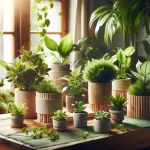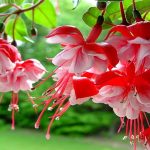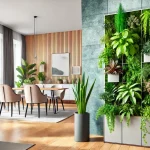This post may contain affiliate links. If you buy something from one of our links we may earn a commission. Thanks
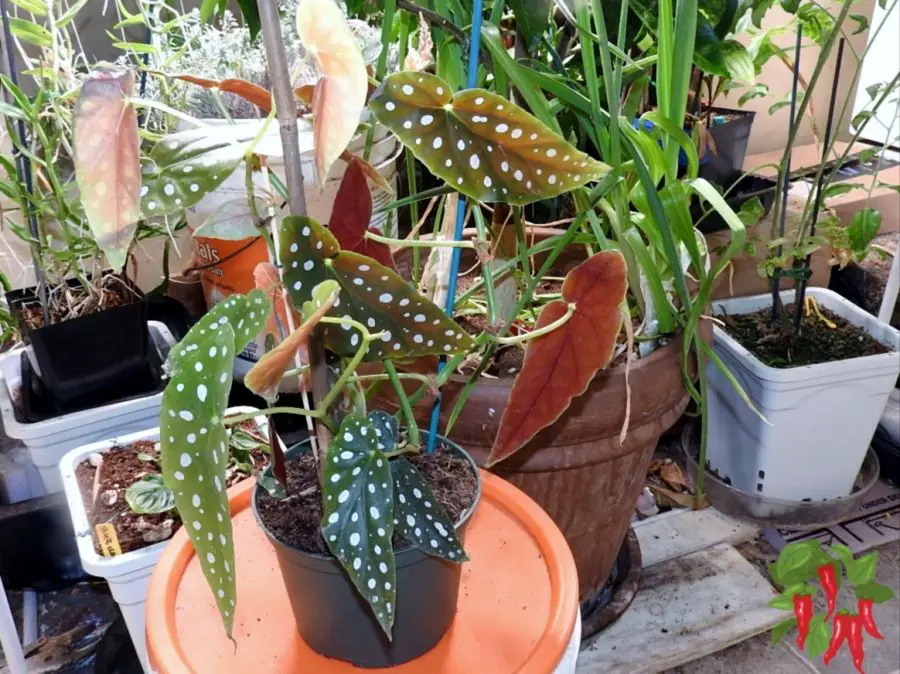
Learn Polka Dot Begonia Care Essentials: Learn how to grow these stunning spotted beauties with our easy tips. Master light, water, and humidity for a thriving indoor showstopper!
Polka Dot Begonia Care Key Takeaways
- Polka Dot Begonia Care requires bright indirect light, consistent moisture, and humidity above 60%.
- Water when the top inch of soil feels dry, and maintain temperatures between 65-75°F.
- Feed monthly during the growing season with balanced fertilizer and provide well-draining soil for best results.
Polka Dot Begonia (Begonia Maculata) Video
Polka Dot Begonia for Sale
Ready to add a Polka Dot Begonia to your indoor garden? I got mine here.
 Begonia Maculata – 6” from California Tropicals
Begonia Maculata – 6” from California Tropicals
Polka Dot Begonia Care: A Comprehensive Guide
Polka Dot Begonia care might seem tricky when you first bring home this stunning spotted beauty, especially if you’ve watched your friends struggle with crispy leaves or drooping stems.
The secret to success with these eye-catching plants isn’t complicated at all – once you understand their basic needs, you’ll have a thriving showstopper that turns heads and starts conversations every time someone visits your home.
Polka Dot Begonia Plant Care Reference Guide
| Characteristic | Details |
|---|---|
| Common Name | Polka Dot Begonia, Spotted Begonia, Trout Begonia |
| Botanical Name | Begonia maculata |
| Native Habitat | Brazil (Southeast regions) |
| Plant Type | Tropical perennial, Cane-type begonia |
| Growth Pattern | Upright, bamboo-like stems with angular leaves |
| Mature Size | 2-4 feet tall, 1-2 feet wide |
| Watering | Keep soil consistently moist but not wet; water when top inch is dry |
| Light/Sun Exposure | Bright indirect light; avoid direct sunlight |
| Soil Type | Well-draining, rich potting mix with perlite |
| Soil pH | 6.0-6.5 (Slightly acidic) |
| Temperature | 65-86°F (18-30°C) |
| Humidity | High humidity (60% or higher) |
| Bloom Time & Flower Color | Spring to fall; clusters of white flowers with pink stems |
| Potential Problems | Powdery mildew, root rot, leaf spot, mealybugs, spider mites |
| Repotting | Every 12-18 months or when rootbound |
| Hardiness Zones (USDA) | 10-11 (typically grown as houseplants) |
The stunning Polka Dot Begonia (Begonia maculata) transforms any indoor space with its dramatic silver-spotted leaves and crimson undersides.
This Brazilian beauty has captured the hearts of indoor gardeners worldwide, offering both visual drama and a rewarding care experience.
Let’s explore how to help this striking plant thrive in your home.
Polka Dot Begonia Flowers
While the spotted foliage steals the show, Polka Dot Begonias produce delicate blooms that add another dimension to their beauty.
Understanding the flowering cycle helps you maximize blooming potential and manage the plant’s energy.
• Clusters of white or pink flowers
• Blooms appear from spring through fall
• Each cluster contains male and female flowers
• Flowers last 2-3 weeks
• Remove spent blooms promptly
• Reduce fertilizer during flowering
• Maintain higher humidity for buds
• Allow natural rest period in winter
• Watch for flower stem elongation
Angel Wing Polka Dot Begonia
This common name refers to the distinctive leaf shape that characterizes this begonia group. Understanding these specific traits helps you maximize their ornamental impact.
• Asymmetrical leaf shape
• Upright, cane-like growth
• Multiple stems from base
• Grows 2-4 feet tall
• Leaf clusters along stems
• Strong structural stems
• Natural branching habit
• Seasonal growth patterns
• Support needs as they mature
 Costa Farms Live Indoor Trending Tropicals Begonia Maculata Plant 15-Inches Tall, White Décor Pot
Costa Farms Live Indoor Trending Tropicals Begonia Maculata Plant 15-Inches Tall, White Décor Pot
Pink Polka Dot Begonia
The pink variation of Polka Dot Begonia offers a softer color palette while maintaining the dramatic spotted pattern. These plants require slightly different care to maintain their distinctive coloring.
• Pink undertones in new growth
• More sensitive to direct sun
• Higher humidity needs
• Slower growth rate
• Deeper color in bright light
• Regular feeding maintains pink hues
• Protection from cold drafts
• Careful watering to prevent spots
• Propagate to maintain color intensity
 Harmony Foliage BubbleBlooms Cracklin Rosie Angel Wing, 6 inch Cane Begonia Dark Curly Leaf with Pink Polkadots
Harmony Foliage BubbleBlooms Cracklin Rosie Angel Wing, 6 inch Cane Begonia Dark Curly Leaf with Pink Polkadots
Polka Dot Begonia Size
Understanding the potential size of your Polka Dot Begonia helps you plan space and provide proper support as it grows. These plants can become quite impressive with proper care.
• Mature height 2-4 feet
• Spread 1-3 feet wide
• Leaf size 4-8 inches
• Growth rate moderate
• Annual size increase
• Containable through pruning
• Support needs by size
• Space requirements
• Container sizing guide
Is Polka Dot Begonia Toxic?
Safety considerations are important when growing Polka Dot Begonias, especially in homes with pets and children.
Being aware of their toxicity helps you make informed decisions about placement.
• Contains calcium oxalate crystals
• Toxic to cats and dogs
• Mild to moderate if ingested
• Skin irritation is possible
• Keep away from children
How to Care for Polka Dot Begonias
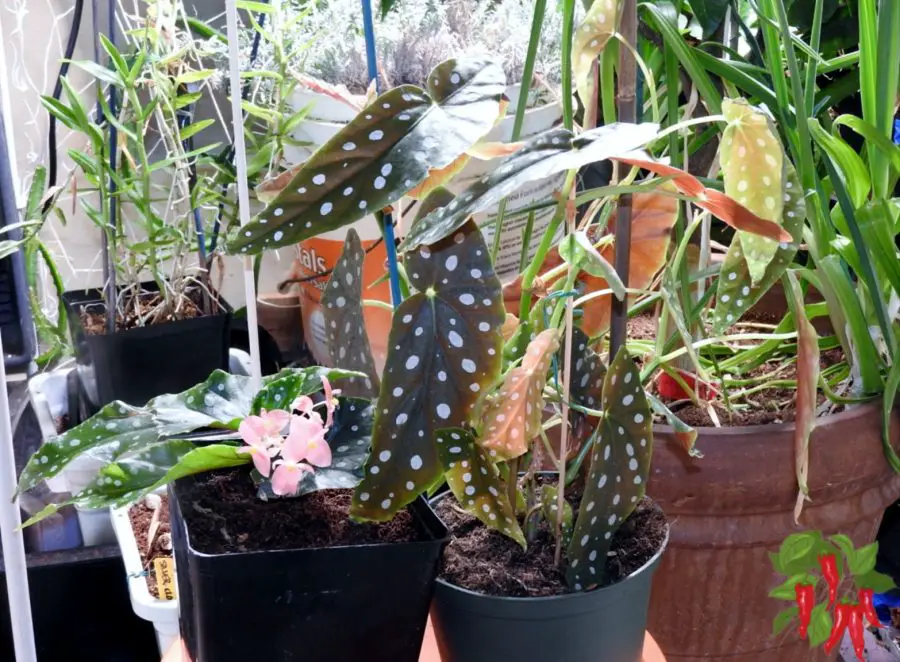
The Polka Dot Begonia transforms any indoor space with its dramatic silver-spotted leaves and rich crimson undersides.
However, getting those perfect spots and vibrant growth means understanding exactly what these tropical beauties need.
Whether you’re bringing home your first spotted stunner or looking to improve your care routine, the secret lies in recreating their native rainforest conditions.
Good news – once you understand their basic needs for bright indirect light, proper humidity, and consistent moisture, these eye-catching plants reward you with lush growth and possibly even delicate blooms that make them true showstoppers in any indoor garden.
Polka Dot Begonia Care Essentials: What You Need To Know
Light and Location
Proper lighting is the foundation of a thriving Polka Dot Begonia. These elegant plants evolved in the dappled light of Brazilian rainforests, perfectly adapting to bright, filtered indoor conditions.
Understanding their light preferences will help you position your begonia for optimal growth and prevent common issues like leaf burn or poor development.
• Place in bright, indirect light
• Protect from harsh afternoon sun
• East or north-facing windows are ideal
• Use sheer curtains to filter direct sunlight
• Rotate the pot quarterly for even growth
Water and Humidity
Maintaining proper moisture balance is crucial for Polka Dot Begonias. These tropical beauties need consistent moisture without becoming waterlogged.
Creating the right humidity environment helps prevent crispy leaf edges and promotes healthy, vibrant foliage.
• Water when the top inch of soil feels dry
• Use room temperature filtered water
• Provide 60% or higher humidity
• Consider using a pebble tray
• Group with other humidity-loving plants
Soil and Fertilizer
Creating the perfect growing environment starts with the right soil mix and nutrition plan.
Polka Dot Begonias thrive in rich, well-draining soil that mimics their natural habitat.
A proper feeding schedule ensures stunning foliage and healthy growth throughout the growing season.
• Use well-draining potting mix
• Add orchid bark for aeration
• Fertilize monthly during the growing season
• Reduce feeding in winter
• Maintain soil pH between 6.0-6.5
Using Coco Coir and Perlite as a Soilless Mix
A blend of coco coir and perlite creates an excellent soilless growing medium for Polka Dot Begonias, offering superior control over moisture and nutrients compared to traditional potting soil.
Ideal Ratio:
• 70% coco coir
• 30% perlite
Benefits of This Soilless Mix:
• Root Health
• Excellent oxygen flow to roots
• Prevents root rot
• Fast drainage while retaining moisture
• Easy to monitor root development
• Superior disease resistance
• Growth Benefits
• Better nutrient uptake
• Faster growth rates
• Easier to maintain consistent moisture
• pH neutral growing environment
• Reduced risk of soil-borne pests
Fertilizing Tips for Soilless Medium:
• Use complete hydroponic fertilizer
• Feed at quarter strength weekly
• Monitor leaf color for nutrient needs
• Flush system monthly to prevent salt buildup
• Adjust pH to 6.0-6.5 when feeding
How to Propagate Polka Dot Begonia
Creating new Polka Dot Begonias from your existing plant is both rewarding and cost-effective.
Spring and early summer provide ideal conditions for propagation when the plant is actively growing and temperatures support root development.
With the right technique, you can expand your collection or share these beautiful plants with friends.
• Choose healthy stems with 2-3 nodes
• Cut just below a node with clean tools
• Remove lower leaves
• Place in water or moist medium
• Maintain warm temperatures
• Keep cuttings in bright indirect light
• Change water weekly if using water propagation
• Expect roots in 2-3 weeks
• Transfer to permanent pot when roots are 2 inches
Repotting
Proper repotting ensures your Polka Dot Begonia continues to thrive and grow. These plants typically need repotting every 18-24 months, or when roots begin circling the bottom of the pot.
Understanding when and how to repot helps prevent stress and promotes healthy growth.
• Choose a pot 1-2 inches larger
• Repot in spring before active growth
• Gently remove from the current pot
• Inspect and trim damaged roots
• Position at the same soil depth
• Water thoroughly after repotting
• Keep in bright indirect light
• Avoid fertilizing for 4-6 weeks
• Monitor for signs of shock
Maintenance
Regular maintenance keeps your Polka Dot Begonia looking its best while preventing common problems.
A consistent care routine helps you spot potential issues early and maintains the plant’s striking appearance.
Taking time for these simple tasks ensures your begonia remains healthy and vibrant.
• Dust leaves monthly with a damp cloth
• Remove yellow or damaged leaves
• Pinch growing tips for bushier growth
• Rotate pot quarterly
• Check for pests weekly
• Clean plant tools between uses
• Remove spent flowers
• Adjust care seasonally
• Document care routine
Pruning
Regular pruning keeps your Polka Dot Begonia shapely and encourages fuller growth.
Understanding when and where to make cuts transforms a leggy plant into a lush, compact specimen that maximizes the impact of those stunning spotted leaves.
• Remove damaged or yellowing leaves at the base
• Pinch growing tips to encourage branching
• Cut back leggy stems to a node
• Trim flower stalks after blooming
• Clean cuts at 45-degree angles
• Save healthy cuttings for propagation
• Prune heaviest in early spring
• Shape throughout growing season
• Remove crossing branches
FAQ Section
Growing Polka Dot Begonias brings up many common questions. We’ve compiled the most frequently asked questions to help you better understand and care for your beautiful spotted begonia.
Q. How do you take care of a Polka Dot Begonia?
A. Provide bright, indirect light, maintain consistently moist but not waterlogged soil, ensure humidity stays above 60%, and keep temperatures between 65°F-75°F. Feed monthly during growing season with balanced fertilizer.
Q. Do Polka Dot Begonias like sun or shade?
A. These plants thrive in bright, indirect light. Direct sunlight can scorch their delicate leaves, while too little light results in leggy growth and poor leaf development.
Q. Are Polka Dot Begonias toxic to pets?
A. Yes, they contain calcium oxalates which are toxic if ingested by pets or humans. Keep plants out of reach of curious pets and small children.
Q. How do you propagate Polka Dot Begonias?
A. Take stem cuttings that include at least two nodes, remove lower leaves, and place in water or moist potting mix. Roots typically develop within 2-3 weeks.
Q. Where do you cut Polka Dot plants for propagation?
A. Make clean cuts just below a node (the point where leaves attach to the stem) using sterilized scissors or pruners.
Q. Will Begonia cuttings root in water?
A. Yes, they root readily in water. Change the water weekly and transplant to soil once roots reach 1-2 inches long.
Q. Why are my begonia’s leaves turning yellow?
A. Usually caused by overwatering or poor drainage. Check soil moisture and ensure proper drainage holes in the pot.
Q. How often should I repot my Polka Dot Begonia?
A. Repot every 18-24 months or when roots begin growing through drainage holes.
Q. Can I keep my begonia outdoors?
A. Only in warm, humid climates in a sheltered location with filtered light. Bring indoors when temperatures drop below 60°F.
Conclusion
Growing a Polka Dot Begonia is a rewarding journey of plant care. As you’ve learned throughout this guide, success comes from understanding their tropical nature and providing consistent care.
Whether you’re growing in traditional soil or exploring soilless mediums, these stunning plants will reward your attention with dramatic foliage and potentially delicate blooms.
Understanding Begonia Varieties
Many indoor gardeners start with a Polka Dot Begonia and soon discover the fascinating world of begonia varieties.
Each type has distinct care requirements and growth patterns that make them unique.
Understanding these differences helps you expand your collection successfully and create stunning indoor displays.
Cane Begonias (Angel Wing Group)
• Grow 2-4 feet tall with bamboo-like stems
• Prefer morning sun, afternoon shade
• Water when top 1 inch of soil dries
• Bloom repeatedly throughout growing season
• Pinch tips to encourage branching
Rex Begonias
• Compact growth, rarely exceed 18 inches
• Need 70%+ humidity to thrive
• Keep soil consistently moist but not wet
• Grow for foliage, not flowers
• Multiple crowns develop from rhizomes
Rhizomatous Begonias
• Spread horizontally through creeping stems
• Allow soil surface to dry between waterings
• Plant shallowly, rhizomes at soil level
• Divide in spring when overcrowded
• Excellent in shallow containers
Indoor Humidity Solutions
Creating proper humidity for tropical plants doesn’t require expensive equipment. Here are proven methods that work in any home environment using simple materials and techniques.
Humidity Tray Setup
• Choose a waterproof tray with raised edges
• Fill with porous material (clay pebbles or gravel)
• Add water below material surface
• Place plants on top, not in water
• Refill when completely dry
Effective Plant Grouping
• Arrange by height for air circulation
• Keep leaves from touching to prevent disease
• Group plants with similar humidity needs
• Create zones based on light requirements
• Rotate positions monthly
Natural Humidity Tips
• Place groups in the bathroom with a shower
• Utilize kitchen humidity when cooking
• Keep away from heating/cooling vents
• Use room dividers to create humid zones
• Place near indoor fountains or aquariums
Monitoring and Adjusting
• Check leaf tips for brown edges
• Feel soil moisture at different depths
• Watch for leaf curling
• Adjust during seasonal changes
• Reduce humidity gradually for hardening
Tropical Plant Care Basics
Moving beyond basic houseplants to tropical varieties requires understanding their natural habitat needs.
By recreating these conditions indoors, you’ll see dramatic growth and vibrant foliage that makes tropical plants truly rewarding.
Light Management
• Identify bright indirect light spots
• Watch for seasonal light changes
• Rotate plants quarterly
• Look for early sunburn signs
• Adjust distance from windows seasonally
Temperature Control
• Maintain 65-80°F daytime range
• Allow 10°F drop at night
• Block cold drafts from windows
• Keep away from AC/heat vents
• Monitor seasonal temperature shifts
Watering Wisdom
• Check soil moisture at 2-inch depth
• Water thoroughly until drainage
• Empty catch trays within 30 minutes
• Reduce watering in winter
• Adjust for humidity levels
Growth Patterns
• Active growth March through September
• Rest period in winter months
• New leaf emergence cycles
• Blooming phases
• Root development seasons
Container Gardening Essentials
Success with indoor tropicals starts with proper container selection and setup. Understanding container basics prevents common problems and promotes healthy root development.
Container Basics
• Size up only 2 inches at a time
• Choose depth based on root type
• Ensure multiple drainage holes
• Allow air gap at soil surface
• Match pot style to watering habits
Drainage Setup
• Layer drainage materials properly
• Create air pockets for roots
• Elevate pots for air flow
• Use pot feet in saucers
• Check drain holes monthly
Bottom Watering Method
• Fill tray with 2 inches of water
• Soak for 15-30 minutes maximum
• Check soil moisture at top
• Drain excess completely
• Allow soil surface to dry between waterings
Growth Space Planning
• Calculate mature plant width
• Allow for seasonal growth spurts
• Plan support structures early
• Space for air circulation
• Consider cleaning access
Key Takeaways
• Provide bright, indirect light for optimal growth
• Maintain consistent moisture without overwatering
• Keep humidity levels high
• Feed regularly during growing season
• Monitor for changes in leaf color or texture
• Protect from cold drafts and temperature swings
• Choose growing medium based on your environment
• Practice regular maintenance for best results
Each home environment is unique, and you may need to adjust these guidelines to match your specific conditions.
Remember that consistency in care leads to the best results, and don’t be afraid to adjust your care routine based on your home’s specific conditions.
Your Polka Dot Begonia can become a stunning focal point in your indoor garden.
This beautiful tropical plant rewards careful attention with stunning displays of spotted foliage.
Learn more: Indoor Apartment Gardening: 15 Point Comprehensive Guide
Visit my Amazon Influencer Page for videos and gardening products Grow Your Own Garden


